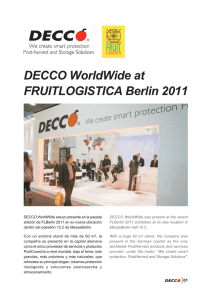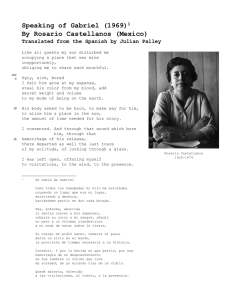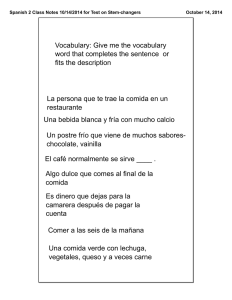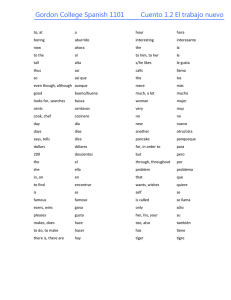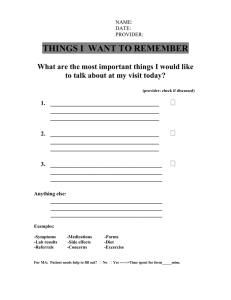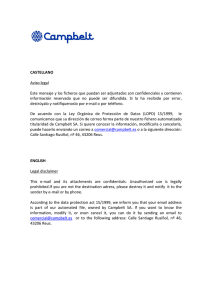The Importance of a Weekly Inventory
Anuncio
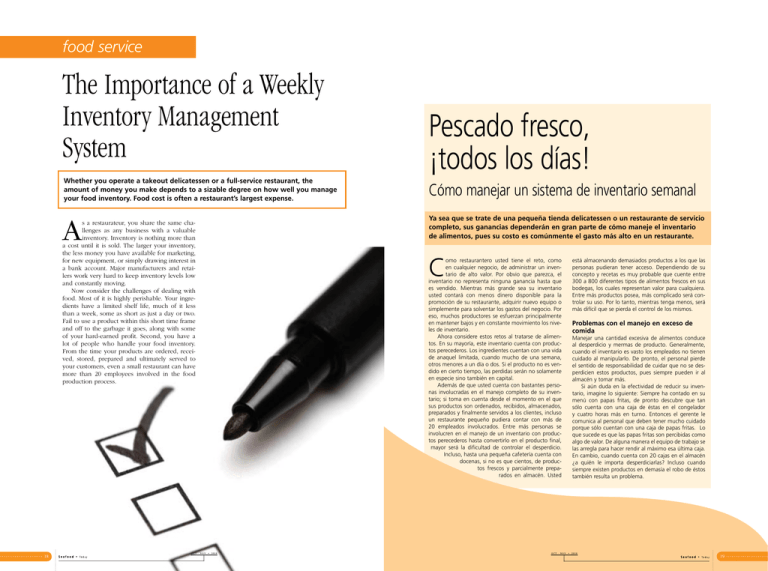
food service The Importance of a Weekly Inventory Management System Whether you operate a takeout delicatessen or a full-service restaurant, the amount of money you make depends to a sizable degree on how well you manage your food inventory. Food cost is often a restaurant’s largest expense. A s a restaurateur, you share the same challenges as any business with a valuable inventory. Inventory is nothing more than a cost until it is sold. The larger your inventory, the less money you have available for marketing, for new equipment, or simply drawing interest in a bank account. Major manufacturers and retailers work very hard to keep inventory levels low and constantly moving. Now consider the challenges of dealing with food. Most of it is highly perishable. Your ingredients have a limited shelf life, much of it less than a week, some as short as just a day or two. Fail to use a product within this short time frame and off to the garbage it goes, along with some of your hard-earned profit. Second, you have a lot of people who handle your food inventory. From the time your products are ordered, received, stored, prepared and ultimately served to your customers, even a small restaurant can have more than 20 employees involved in the food production process. 18 Pescado fresco, ¡todos los días! Cómo manejar un sistema de inventario semanal Ya sea que se trate de una pequeña tienda delicatessen o un restaurante de servicio completo, sus ganancias dependerán en gran parte de cómo maneje el inventario de alimentos, pues su costo es comúnmente el gasto más alto en un restaurante. C omo restaurantero usted tiene el reto, como en cualquier negocio, de administrar un inventario de alto valor. Por obvio que parezca, el inventario no representa ninguna ganancia hasta que es vendido. Mientras más grande sea su inventario usted contará con menos dinero disponible para la promoción de su restaurante, adquirir nuevo equipo o simplemente para solventar los gastos del negocio. Por eso, muchos productores se esfuerzan principalmente en mantener bajos y en constante movimiento los niveles de inventario. Ahora considere estos retos al tratarse de alimentos. En su mayoría, este inventario cuenta con productos perecederos. Los ingredientes cuentan con una vida de anaquel limitada, cuando mucho de una semana, otros menores a un día o dos. Si el producto no es vendido en cierto tiempo, las perdidas serán no solamente en especie sino también en capital. Además de que usted cuenta con bastantes personas involucradas en el manejo completo de su inventario; si toma en cuenta desde el momento en el que sus productos son ordenados, recibidos, almacenados, preparados y finalmente servidos a los clientes, incluso un restaurante pequeño pudiera contar con más de 20 empleados involucrados. Entre más personas se involucren en el manejo de un inventario con productos perecederos hasta convertirlo en el producto final, mayor será la dificultad de controlar el desperdicio. Incluso, hasta una pequeña cafetería cuenta con docenas, si no es que cientos, de productos frescos y parcialmente preparados en almacén. Usted está almacenando demasiados productos a los que las personas pudieran tener acceso. Dependiendo de su concepto y recetas es muy probable que cuente entre 300 a 800 diferentes tipos de alimentos frescos en sus bodegas, los cuales representan valor para cualquiera. Entre más productos posea, más complicado será controlar su uso. Por lo tanto, mientras tenga menos, será más difícil que se pierda el control de los mismos. Problemas con el manejo en exceso de comida Manejar una cantidad excesiva de alimentos conduce al desperdicio y mermas de producto. Generalmente, cuando el inventario es vasto los empleados no tienen cuidado al manipularlo. De pronto, el personal pierde el sentido de responsabilidad de cuidar que no se desperdicien estos productos, pues siempre pueden ir al almacén y tomar más. Si aún duda en la efectividad de reducir su inventario, imagine lo siguiente: Siempre ha contado en su menú con papas fritas, de pronto descubre que tan sólo cuenta con una caja de éstas en el congelador y cuatro horas más en turno. Entonces el gerente le comunica al personal que deben tener mucho cuidado porque sólo cuentan con una caja de papas fritas. Lo que sucede es que las papas fritas son percibidas como algo de valor. De alguna manera el equipo de trabajo se las arregla para hacer rendir al máximo esa última caja. En cambio, cuando cuenta con 20 cajas en el almacén ¿a quién le importa desperdiciarlas? Incluso cuando siempre existen productos en demasía el robo de éstos también resulta un problema. 19 Carrying excess food products ties up your valuable cash and leads to excessive food waste and spoilage The more people involved in taking “raw” inventory and converting it to the delivered product, the more difficult it is to control loss, waste and misuse of inventory. Even a small eatery has dozens if not hundreds of raw and partially prepared food products in storage. You’re stocking lots of desirable products to which many people have access. Depending on your concept and recipes there’s a good chance that you’ll have between 300 and 800 different raw food products in your storage rooms that are of value to everyone. The more products you have, the more challenging it is to control their use. The more of anything you have, the less likely one or two items will be immediately missed. Problems with Carrying Too Much Food Carrying excess food products ties up your valuable cash and leads to excessive food waste and spoilage. It results in overportioning and misuse of your valuable food products because employees become careless when there’s always an overabundant supply of food. Employees don’t have to be all that concerned about using products sparingly because there’s little risk of “running out” when there’s always more in the storage room or walk-in. If you still harbor doubt about the effectiveness of reducing inventory, consider the following. If you’ve ever served fries, you’ve probably made the horrifying discovery that there is only one box left in the freezer and four hours left in the shift. So the manager tells everyone to be real careful with fries because there is only a box left, and guess what happens? Fries are immediately perceived as a valuable commodity. Somehow the staff manages to scrape by with the last box. Everyone’s handling them with kid gloves because they’re scarce. They’re valuable. When there are 20 boxes in the walk-in who cares about fries? Nobody. That’s when you see them flying around the kitchen and 2 inches deep all over the floor. Also, when products are always in abundant supply, theft tends to be more of a problem. Determine Your Inventory Level in Two Steps An easy way to get an instant gauge on whether you’re carrying an appropriate amount of inventory is to calculate your “number of days of inventory on hand.” It tells you how many days your existing inventory will last (assuming you’re carrying the 20 right mix of products) based on how much food you’re using in an average day, which translates to your average daily food cost. Calculating your “number of days of inventory” on hand is a twostep process: Manejar una cantidad excesiva de alimentos conduce al desperdicio y mermas de producto Determine los niveles de su inventario en dos pasos Una manera fácil para determinar si está haciendo un buen manejo de su inventario es calcular “el número de días del inventario en mano”, esto le dirá cuántos días durarán sus productos almacenados (asumiendo que cuenta con los adecuados) basados en cuánta comida esté utilizando en promedio por día, lo que se traduce al porcentaje del costo diario por alimentos. Calculando el “número de días en su inventario a mano” es un proceso de dos pasos: PASO 1: Calcular el porcentaje del costo de comida por día Porcentaje del costo de comida por día = Costo de comida / Número de días por periodo STEP 1: Calculate Average Daily Food Cost: Average Daily Food Cost = Food Cost / Number of Days in Period STEP 2: Calculate Days Sales in Inventory: Days Sales in Inventory = Ending Food Inventory / Average Daily Food Cost Here’s an example: You need the following information to calculate the number of Days Sales in Inventory. You should be able to get these numbers right off your financial statements: Number of days in the period = 30 Food cost for the period (from the profit and loss statement) = $30,000 Ending food inventory (on the balance sheet) = $10,000 STEP 1: Calculate Average Daily Food Cost: $30,000 / 30 days = $1,000 STEP 2: Calculate Days Sales in Inventory: $10,000 / $1,000 = 10 days’ worth of food on hand In the above example, having 10 days’ worth of inventory would probably indicate that there’s too much food on the shelves. If operationally feasible, lowering inventory levels to six or seven days of sales would cause food cost to drop immediately, everything else being equal. PASO 2: Calcular los días de ventas en Inventario: Días de ventas en inventario= Inventario agotado / Porcentaje del costo de comida por día Un ejemplo: Necesitará la siguiente información para calcular el número de días en ventas en inventario. Deberá poder obtener estos números de sus estados de cuenta: Número de días (mes) = 30 Costo de comida por mes (tomado del Estado de pérdidas y ganancias) = $30,000 Inventario remanente (de la hoja de balance) = $ 10,000 PASO 1: $ 30,000 / 30 días = $ 1,000 PASO 2: Calcular los días de ventas en inventario: $ 10,000 / $1,000 = 10 días disponibles de comida almacenada But If You Really Want to Do it Well, Do It Once a Week Most independent restaurants calculate their food cost once a month. Virtually all the major chain restaurants calculate their food cost each week. According to industry averages, chain restaurants (before corporate expenses) are two to three times as profitable as independent restaurants. Many restaurants, regardless of whether they calculate their weekly food cost, keep a record of their purchases each day. So, if you’re already doing this, it will be easy to separate the food purchases on each invoice. Start your weekly inventory; your pocket will appreciate it a lot! Article based on the advices of Restaurant Owner for new restaurateurs. En el ejemplo anterior, contando con 10 días de exceso de inventario podría indicar que hay demasiada comida en almacén. Hágalo bien una vez por semana Muchos restaurantes independientes calculan el costo de sus alimentos una vez por mes; sin embargo, las cadenas de restaurantes calculan el costo de su comida cada semana. De acuerdo a los porcentajes de la industria, los restaurantes de cadena son de dos a tres veces más rentables que los restaurantes independientes. A pesar de que se calcule o no el gasto de los alimentos por semana, muchos restaurantes sí mantienen un récord de sus gastos por día. Si ya está haciendo esto, será más fácil separar los gastos en alimentos y calcular el inventario semanal, entonces evitará el desperdicio de productos, pero sobre todo cuidará su inversión. Artículo basado en las recomendaciones de Restaurant Owner para nuevos restauranteros. 21
